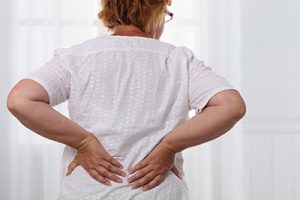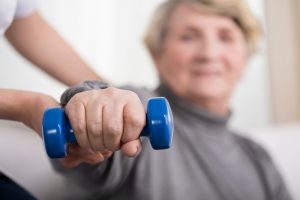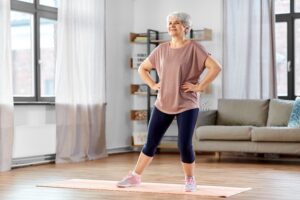Does menopause cause more joint and muscle pain?

 Menopause is a normal physiologic process that occurs in all menstruating females and is defined as the permanent cessation of menstrual cycles due to the body stopping the production of reproductive hormones from the ovaries for at least 12 months (1). This occurs in most females between the ages of 45 and 56 and the hormonal changes that occur during menopause affect the body in various ways including;
Menopause is a normal physiologic process that occurs in all menstruating females and is defined as the permanent cessation of menstrual cycles due to the body stopping the production of reproductive hormones from the ovaries for at least 12 months (1). This occurs in most females between the ages of 45 and 56 and the hormonal changes that occur during menopause affect the body in various ways including;
- hot flushes and night sweats.
- changes in the regularity and flow of the menstrual cycle, culminating in cessation of menstruation.
- vaginal dryness, pain during sexual intercourse, and incontinence.
- difficulty sleeping/insomnia; and
- changes in mood, depression, and anxiety (1)
Another commonly reported symptom experienced during menopause is an increase in aches and pains of various types (2) with nearly half of all menopausal women reporting such symptoms. In contrast, only 25% of pre-menopausal women report similar symptoms (3, 4).
Why would the menopause cause an increase in women reporting aches and pains?
The Reduction of Oestrogen
The reduction in the production of estrogen plays a large part in the symptoms commonly displayed during menopause (1).
Oestrogen and Cartilage
Oestrogen plays an important role in the maintenance of musculoskeletal structures especially when it comes to its role in maintaining cartilage in joints. Cartilage is important for joints to move smoothly, its reduction as we get older is what starts the process of osteoarthritis (5). Two different oestrogen receptors have been found in the chondrocytes of cartilage, chondrocytes are responsible for the production of cartilage meaning that as the oestrogen reduces during menopause resulting in less chondrocyte activity and an increased rate of loss of joint cartilage (6). The effects of this are seen by the prevalence of arthritic symptoms being larger in men under 50 but then subsequently becomes larger in women after 50, and that hip and knee osteoarthritis are more likely to be symptomatic in postmenopausal women than same-aged men (6).
With this in mind, there have been some studies into the use of hormone replacement therapy to slow the effects of arthritic symptoms. Still, the conclusions are mixed, and often contradictory meaning at this time HRT is not recommended in the treatment of osteoarthritis.
Oestrogen and muscle mass
Oestrogen also plays a role in maintaining muscle mass which is crucial for maintaining strength (7). All of us lose muscle mass as we get older, however, the reduction of oestrogen during menopause accelerates this process leading to a reduction in overall strength. Muscles that lack strength are more susceptible to injury while under load which can be the source of aches and pains, while engaging in strength training as part of an overall fitness program can help improve muscle mass and strength (8).
Oestrogen and tendons
Other tissues such as ligaments and tendons are also affected by the reduction in oestrogen. The change is a loss of tensile strength which would produce a change in how your joints and muscles cope with load which can contribute to painful conditions such as tendinopathies that are commonly seen in menopausal women (9).
Two other factors are also involved in the increased incidence of musculoskeletal pain during menopause.
Weight Gain
 Women in middle age tend to have a higher Body Mass Index (10), and the prevalence of obesity is higher during menopause (11) so it is frequently noted in research that perimenopausal women who have a higher BMI report more musculoskeletal pain (12). This may be linked to some of the factors mentioned earlier in that obesity is a contributory factor to various types of arthritis, either through load on a joint such as a knee (13), or the inflammatory effects of having more fat cells (14). As Body Mass Index does not take into account body composition (fat cells vs muscle cells) the muscle loss seen in menopause may mean that menopausal women who are obese may have less muscle mass but more fat cells further contributing to the joint instability and muscle weakness that can produce pain (14, 15).
Women in middle age tend to have a higher Body Mass Index (10), and the prevalence of obesity is higher during menopause (11) so it is frequently noted in research that perimenopausal women who have a higher BMI report more musculoskeletal pain (12). This may be linked to some of the factors mentioned earlier in that obesity is a contributory factor to various types of arthritis, either through load on a joint such as a knee (13), or the inflammatory effects of having more fat cells (14). As Body Mass Index does not take into account body composition (fat cells vs muscle cells) the muscle loss seen in menopause may mean that menopausal women who are obese may have less muscle mass but more fat cells further contributing to the joint instability and muscle weakness that can produce pain (14, 15).
Depression/Anxiety
The prevalence of depressive symptoms in perimenopausal women increases during menopause, while the prevalence of anxiety nearly doubles when compared to premenopausal women (16). Several studies have shown a strong co-occurrence of chronic pain and anxiety/depressive symptoms in women going through menopause (14, 17) with anxiety being more closely associated with hypersensitivity to pain and the presence of physical symptoms (18).
So, women going through menopause will experience higher levels of aches and pains due to the hormonal changes inherent in menopause, but these effects are significantly influenced by other changes seen in menopause and middle age such as having a high BMI and depression/anxiety states.
How to reduce pain during menopause
Whereas it is unrealistic to expect menopause not to have any effect on your body the level of them can be reduced by living a healthier lifestyle.
A regular exercise program has been shown to be helpful with weight loss and maintaining muscle mass (19), as well as being a recommended intervention in helping control the symptoms of arthritis (20) and depression/anxiety symptoms (21).
Having a healthy diet is also crucial to maintaining a good weight, but it is also important in helping to avoid depressive symptoms (22), reducing the effects of osteoarthritis (23), and maintaining muscle mass (24).
Do you want to know what is causing your pain and if we can help? Why not take advantage of our new patient assessment introductory offer to get you started towards a tailor-made recovery plan for only £19.
Are you in a lot of pain and want to get better as soon as possible? If so then why not book in for a new patient consultation, with treatment on the day, for £75.
References
1 – Peacock K, Carlson K, Ketvertis KM. Menopause. [Updated 2023 Dec 21]. In: StatPearls [Internet]. Treasure Island (FL): StatPearls Publishing; 2024 Jan-. Available from: https://www.ncbi.nlm.nih.gov/books/NBK507826/
2 – Szoeke C. E., Cicuttini F. M., Guthrie J. R., Dennerstein L. The relationship of reports of aches and joint pains to the menopausal transition: a longitudinal study. Climacteric. 2009;11(1):55–62. doi: 10.1080/13697130701746006.
3 – Dedicação AC. Prevalence of musculoskeletal pain in climacteric women of a basic health unit in São Paulo/SP. Rev Dor. SãO Paulo. 2017;18:212–6.
4 – Gao HL, Lin SQ, Wei Y, Chen Y, Wu ZL. The effect of age and menopausal status on musculoskeletal symptoms in Chinese women aged 35-64 years. Climacteric. 2013 Dec;16(6):639-45. doi: 10.3109/13697137.2013.769095. Epub 2013 Feb 15. PMID: 23347340.
5 – Allen N. Wilkins, Edward M. Phillips, Chapter 130 – Osteoarthritis, Editor(s): Walter R. Frontera, Julie K. Silver, Thomas D. Rizzo, Essentials of Physical Medicine and Rehabilitation (Second Edition), W.B. Saunders, 2008, Pages 745-751, https://doi.org/10.1016/B978-1-4160-4007-1.50132-2.
6 – Pascal Richette, Maïté Corvol, Thomas Bardin, Estrogens, cartilage, and osteoarthritis, Joint Bone Spine, Volume 70, Issue 4, 2003, Pages 257-262, https://doi.org/10.1016/S1297-319X(03)00067-8.
7 – Brittany C. Collins, Eija K. Laakkonen, Dawn A. Lowe, Aging of the musculoskeletal system: How the loss of estrogen impacts muscle strength, Bone, Volume 123, 2019, Pages 137-144, https://doi.org/10.1016/j.bone.2019.03.033.
8 – Von Mechelen W, Hlobil H, Kemper HC. Incidence, severity, aetiology and prevention of sports injuries. A review of concepts. Sports Med 1992;14:82-99.
9 – Frizziero A, Vittadini F, Gasparre G, Masiero S. Impact of oestrogen deficiency and aging on tendon: concise review. Muscles Ligaments Tendons J. 2014 Nov 17;4(3):324-8. PMID: 25489550; PMCID: PMC4241423.
10 – Davis SR, Castelo-Branco C, Chedraui P, Lumsden MA, Nappi RE, Shah D, Villaseca P, Writing Group of the International Menopause Society for World Menopause Day 2012. Understanding weight gain at menopause. Climacteric 2012;15:419–29.
11 – Tang R, Fan Y, Luo M, Zhang D, Xie Z, Huang F, Wang Y, Liu G, Wang Y, Lin S, Chen R. General and central obesity are associated with increased severity of the VMS and sexual symptoms of menopause among Chinese women: a longitudinal study. Front Endocrinol (Lausanne) 2022;13:814872.
12 – Huang F, Fan Y, Tang R, Xie Z, Yang L, Ma X, Liang J, Chen R. Musculoskeletal pain among Chinese women during the menopausal transition: findings from a longitudinal cohort study. Pain. 2024 Nov 1;165(11):2644-2654. doi: 10.1097/j.pain.0000000000003283
13 – Grotle M, Hagen KB, Natvig B, Dahl FA, Kvien TK. Obesity and osteoarthritis in knee, hip and/or hand: an epidemiological study in the general population with 10 years follow-up. BMC Musculoskelet Disord 2008;9:132
14 – Messier SP. Obesity and osteoarthritis: disease genesis and nonpharmacologic weight management. Med Clin North Am 2009;93:145–59. xi–xii.
15 – Godziuk K, Prado CM, Woodhouse LJ, Forhan M. The impact of sarcopenic obesity on knee and hip osteoarthritis: a scoping review. BMC Musculoskelet Disord 2018;19:271.
16 – Tang R, Luo M, Li J, Peng Y, Wang Y, Liu B, Liu G, Wang Y, Lin S, Chen R. Symptoms of anxiety and depression among Chinese women transitioning through menopause: findings from a prospective community-based cohort study. Fertil sterility 2019;112:1160–71
17 – De La Rosa JS, Brady BR, Ibrahim MM, Herder KE, Wallace JS, Padilla AR, Vanderah TW. Co-occurrence of chronic pain and anxiety/depression symptoms in U.S. adults: prevalence, functional impacts, and opportunities. PAIN 2024;165:666–73.
18 – Thurston RC, Bromberger JT, Joffe H, Avis NE, Hess R, Crandall CJ, Chang Y, Green R, Matthews KA. Beyond frequency: who is most bothered by vasomotor symptoms? Menopause (New York, NY) 2008;15:841–7.
19 – Cox CE. Role of Physical Activity for Weight Loss and Weight Maintenance. Diabetes Spectr. 2017 Aug;30(3):157-160. doi: 10.2337/ds17-0013.
20 – Intentional Weight Loss for Overweight and Obese Knee Osteoarthritis Patients: Is More Better? Messier SP, Resnik AE, Beavers DP, Mihalko SL, Miller GD, Nicklas BJ, DeVita P, Hunter DJ, Lyles MF, Eckstein F, Guermazi A, Loeser RF. Arthritis Care Res (Hoboken). 2018 Jun 18. doi: 10.1002/acr.23608.
21 – De Moor MH, Beem AL, Stubbe JH, Boomsma DI, De Geus EJ. Regular exercise, anxiety, depression and personality: a population-based study. Prev Med. 2006 Apr;42(4):273-9. doi: 10.1016/j.ypmed.2005.12.002.
22 – Selvaraj R, Selvamani TY, Zahra A, Malla J, Dhanoa RK, Venugopal S, Shoukrie SI, Hamouda RK, Hamid P. Association Between Dietary Habits and Depression: A Systematic Review. Cureus. 2022 Dec 9;14(12):e32359. doi: 10.7759/cureus.32359
23 – Buck AN, Vincent HK, Newman CB, Batsis JA, Abbate LM, Huffman KF, Bodley J, Vos N, Callahan LF, Shultz SP. Evidence-Based Dietary Practices to Improve Osteoarthritis Symptoms: An Umbrella Review. Nutrients. 2023 Jul 6;15(13):3050. doi: 10.3390/nu15133050.
24 – Sousa LGO, Marshall AG, Norman JE, Fuqua JD, Lira VA, Rutledge JC, Bodine SC. The effects of diet composition and chronic obesity on muscle growth and function. J Appl Physiol (1985). 2021 Jan 1;130(1):124-138. doi: 10.1152/japplphysiol.00156.2020.



